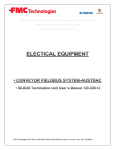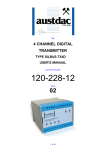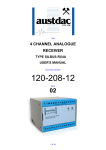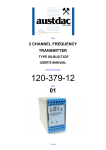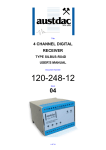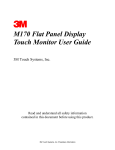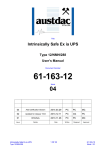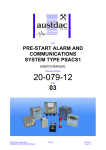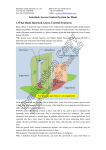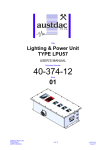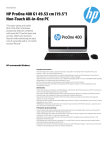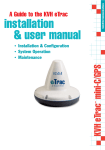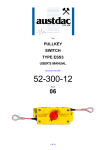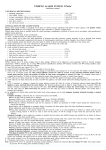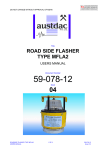Download user manual
Transcript
Title SILBUS TERMINATION UNIT TYPE SILBUS-OAS1 USER'S MANUAL Document Number 120-339-12 Issue 02 1 OF 21 REVISION CONTROL 02 Add settings table 2012.08.20 JY JY CG 01 Original 2010.01.18 PB’ PB’ JY Issue Details Date Written Designed Approved Austdac Pty Ltd Unit 1 / 4 Packard Avenue Castle Hill NSW 2154 Australia PO Box 6486 Baulkham Hills Business Centre NSW 2153 Australia Phone: + 61 2 8851 5000 Fax: + 61 2 9899 2490 Website: www.austdac.com.au Austdac Inc. 455 Lowries Run Rd, Pittsburgh, PA 15237 USA Phone: +1 888 254 9155 Fax: +1 412 635 0179 Copyright 2010-01-18 This document remains the property of Austdac Pty. Ltd. It is subject to its recall and must not be reproduced in part or whole or its contents divulged to third parties without prior written approval from Austdac Pty Ltd. SILBUS TERMINATION UNIT TYPE SILBUS-OAS1 USER'S MANUAL 2 OF 21 120-339-12 Issue: 02 TABLE OF CONTENTS REVISION CONTROL .................................................................................................................... 2 TABLE OF CONTENTS .................................................................................................................. 3 PHOTOGRAPHS ............................................................................................................................ 3 TABLES.......................................................................................................................................... 3 FIGURES........................................................................................................................................ 3 1 GENERAL DESCRIPTION .......................................................................................................... 4 2 FRONT PANEL LAYOUT............................................................................................................. 4 3 THEORY OF OPERATION .......................................................................................................... 5 3.1 TRANSMISSION LINE .......................................................................................................... 5 3.2 PRACTICAL INSTALLATIONS ............................................................................................. 8 3.2.1 SHORT CABLE RUN ..................................................................................................... 8 3.2.2 LONG CABLE RUN........................................................................................................ 8 3.2.3 MULTIPLE WIRE SYSTEM ............................................................................................ 9 3.2.4 HIGH CAPACITANCE CABLES ..................................................................................... 9 3.2.5 SILBUS LOADS ............................................................................................................. 9 3.3 LIGHTNING PROTECTION .................................................................................................. 9 4 TYPICAL APPLICATIONS ......................................................................................................... 10 4.1 THREE-WIRE CONVEYOR ................................................................................................ 10 4.2 TWO-WIRE CONVEYOR.................................................................................................... 11 5 OPERATING INSTRUCTIONS .................................................................................................. 11 6 CONFIGURATION..................................................................................................................... 13 TERMINATIONS AND CONNECTIONS ....................................................................................... 20 6.1 EARTH CONNECTIONS..................................................................................................... 21 7 SPECIFICATIONS ..................................................................................................................... 21 PHOTOGRAPHS Photograph 1 SILBUS-OAS1-XXX front panel layout...................................................................... 4 Photograph 2 Access to configuration switch and potentiometer..................................................... 5 Photograph 3 Termination switch and potentiometer .................................................................... 13 TABLES Table 1 Test facility connection details.......................................................................................... 11 Table 2 DIP Switch Setting ........................................................................................................... 12 Table 3 CAC5 2 wire OAS1 Settings............................................................................................. 14 Table 4 CAC5 3 wire OAS1 Settings............................................................................................. 15 Table 5 CAC6 2 wire OAS1 Settings............................................................................................. 16 Table 6 CAC6 3 wire OAS1 Settings............................................................................................. 17 Table 7 CAC7 2 wire OAS1 Settings............................................................................................. 18 Table 8 CAC7 3 wire OAS1 Settings............................................................................................. 19 Table 9 Termination unit connection details .................................................................................. 20 FIGURES Figure 1 Near end and far end waveforms with no termination (CAC7)........................................... 6 Figure 2 Near end and far end waveforms with termination (CAC7 and 150R + 100nF) ................. 7 Figure 3 Near end and far end waveforms with termination (CAC7 and 150R + 300nF) ................. 7 Figure 4 Near end waveform showing the effect of high capacitance on slew rate .......................... 8 Figure 5 Three-wire conveyor termination and control panel lightning protection .......................... 10 Figure 6 Two-wire conveyor termination and control panel lightning protection............................. 11 Figure 7 SILBUS-OAS1-XXX terminal diagram............................................................................. 20 Figure 8 Typical connection diagrams........................................................................................... 20 SILBUS TERMINATION UNIT TYPE SILBUS-OAS1 USER'S MANUAL 3 OF 21 120-339-12 Issue: 02 1 GENERAL DESCRIPTION The SILBUS termination unit type SILBUS-OAS1-XXX is an explosion protected DIN railmounting module that is used to provide a SILBUS network termination, SILBUS test points and head-end lightning protection. Typically a termination unit is required at both ends of a SILBUS network or transmission line to help stop reflections and ringing in the SILBUS waveform. The SILBUS-OAS1-XXX is produced in two versions, the SILBUS-OAS1-BEG for the head-end and the SILBUS-OAS1-END for the tail-end of the SILBUS network. The SILBUS-OAS1-BEG provides network termination, test facilities as well as lightning protection for head-end control panels while the SILBUS-OAS1-END only provides network termination and test facilities. The termination unit is housed within a DIN rail mounting enclosure measuring 45mm (W) x 75mm (H) x 110mm (D). The front panel is located between the two top of enclosure mounted terminal blocks to provide easy access to the two test points. 2 FRONT PANEL LAYOUT The termination front panel is located between the terminal blocks that form part of the enclosure. The front panel has two 2mm test points spaced at 19mm that provide test access to the SILBUS signal and common signals. The front panel is shown in photograph 1 below. Photograph 1 SILBUS-OAS1-XXX front panel layout SILBUS TERMINATION UNIT TYPE SILBUS-OAS1 USER'S MANUAL 4 OF 21 120-339-12 Issue: 02 The front panel can be snapped out and removed by using a wide bladed flat screw driver to gain access to the configuration potentiometer and switch. Photograph 2 below shows the front panel removed and the location of the configuration potentiometer and switch. The two test sockets are also shown. Photograph 2 Access to configuration switch and potentiometer 3 THEORY OF OPERATION SILBUS or Dupline® is an extremely reliable and noise tolerant system that is in most cases tolerant of unterminated networks, but some installations due line length, branches and system architecture require line termination to function reliably. 3.1 TRANSMISSION LINE The SILBUS signal on a cable follows the principles of transmission line theory. If a transmission line is not terminated correctly at its end points reflections can occur that will cause ringing on the SILBUS waveform. This ringing can cause the channel generator to misinterpret the channel pulse low period and falsely decide that a channel is on when it is not. By correctly terminating the ends of a SILBUS network transmission line the ringing can be eliminated or significantly reduced to a point where it will not cause any incorrect operation of the SILBUS system. SILBUS TERMINATION UNIT TYPE SILBUS-OAS1 USER'S MANUAL 5 OF 21 120-339-12 Issue: 02 The waveform below shows both the near end and far end waveforms on an unterminated cable. Strong reflections can be seen at both the falling edge and rising edge of the waveform. Figure 1 Near end and far end waveforms with no termination (CAC7) If the cable is terminated in the correct impedance a significant improvement in the signal quality can be seen. In the waveform below the same cable has been terminated with a 150ohms in series with 100nF. However as the GSW1 source impedance is lower than the cable impedance some reflections are still evident. SILBUS TERMINATION UNIT TYPE SILBUS-OAS1 USER'S MANUAL 6 OF 21 120-339-12 Issue: 02 Figure 2 Near end and far end waveforms with termination (CAC7 and 150R + 100nF) By adding capacitance to the line this forms a low pass filter which attenuates the reflection due to the GSW1 source impedance mismatch. In the waveform below the same cable has been terminated with a 150ohms in series with 300nF. Figure 3 Near end and far end waveforms with termination (CAC7 and 150R + 300nF) SILBUS TERMINATION UNIT TYPE SILBUS-OAS1 USER'S MANUAL 7 OF 21 120-339-12 Issue: 02 The additional factor that must be taken into account is the overall delay of the SILBUS signal. The delay is due to both the length of the cable and the slew rate of the signal. The GSW1 Build 1 can tolerate a delay of 110us and the GSW1 Build 2 can tolerate a delay of 200us. While additional capacitance helps attenuate the reflection it can add delay due to slew rate. Figure 4 Near end waveform showing the effect of high capacitance on slew rate 3.2 PRACTICAL INSTALLATIONS In practice the installations will vary considerable from the ideal situation. The following describes the effect of various installations. 3.2.1 SHORT CABLE RUN Short cable runs of less than 4km require good termination of the cable as the unterminated cable will generate a strong reflection as there is in-sufficient cable attenuation or capacitance to suppress the reflection. In these cases the OAS1 is used to terminate the cable as well as adding capacitance with the OAS1 to attenuate the driving end reflection. 3.2.2 LONG CABLE RUN Long cable runs of 4km or more generally have less reflection issues as the attenuation of the cable and added capacitance of the cable tends to suppress the reflection. In many cases it may not be necessary to use an OAS1. However it is still recommended that an OAS1 be used to terminate the cable however a lower capacitance value in the OAS1 should be used to reduce the effect on slew rate. SILBUS TERMINATION UNIT TYPE SILBUS-OAS1 USER'S MANUAL 8 OF 21 120-339-12 Issue: 02 3.2.3 MULTIPLE WIRE SYSTEM Multiple wire systems such as a 3 wire system increase the capacitance on the cable due to capacitive addition. It is recommended that the OAS1 is used to terminate each wire unless a high capacitance cable is used. The capacitance value of the OAS1 needs to be reduced to compensate for the cable capacitance. Because of the typical use of a 3 wire system there may be times when one of the wires is open circuited. This disconnects the OAS1 on that line. This may lead to reflections due to the loss of termination. Ideally the isolation switch should switch in a termination at the break to maintain transmission line operation. 3.2.4 HIGH CAPACITANCE CABLES As discussed previously if the cable and OAS1 capacitance is high the slew rate of the signal will be affected. This slew rate will affect the maximum length of the cable that can be used. 3.2.5 SILBUS LOADS SILBUS loads acts as partial termination loads and can affect the final setting of the OAS1. Generally the greater the number of loads the lower the need for the OAS1. 3.3 LIGHTNING PROTECTION The SILBUS-OAS1-BEG provides lightning protection in the form of semiconductor clamping and gas discharge tube clamping with diversion to earth. Further protection is provided by common mode and differential inductive isolation. A high speed semiconductor clamp between the signal and common lines will clamp any differential lightning induced voltages to approximately 22 volts. This clamp is backed up by a differential and common mode three terminal gas discharge device that shunts lightning induced energy away to earth. Lightning induced energy is typically very high frequency so inductive filters are used to isolate the control panel terminals of the SILBUS-OAS1-BEG from high energy spikes. It is for this same high frequency that any wiring from the earth terminals of the SILBUS-OAS1-BEG must be carried out in a low inductive manner, failure to do so will render the SILBUS-OAS1-BEG ineffective in reducing damage from lightning induced energy. SILBUS TERMINATION UNIT TYPE SILBUS-OAS1 USER'S MANUAL 9 OF 21 120-339-12 Issue: 02 4 TYPICAL APPLICATIONS 4.1 THREE-WIRE CONVEYOR 11 SIGNAL (MONITOR) TERMINATION UNIT TYPE SILBUS-OAS1-END 14 COMMON 1 SIGNAL LANYARD LANYARD8 MONITOR MONITOR11 TO CHANNEL GENERATOR AND REMAINDER OF PANEL TERMINATION UNIT TYPE SILBUS-OAS1-BEG 3 COMMON SWITCH TX A? 11 SIGNAL (MONITOR) EOL TX P7 EOL TX P8 TERMINATION UNIT TYPE SILBUS-OAS1-END COMMON COMMON 14 14 COMMON 6 EARTH1 7 EARTH2 EARTH EARTH HEAD-END CONTROL PANEL TAIL-END UNIT Figure 5 Three-wire conveyor termination and control panel lightning protection The figure above shows how the SILBUS-OAS1-BEG and two SILBUS-OAS1-END can be used to correctly terminate a three wire conveyor control system to prevent ringing and resultant interference with the SILBUS signal waveform. The SILBUS-OAS1-BEG also provides lightning protection to the conveyor control panel. The SILBUS-OAS1-END does not provide any lightning protection. The individual transmitters distributed along the conveyor should also be protected against lightning if required. SILBUS TERMINATION UNIT TYPE SILBUS-OAS1 USER'S MANUAL 10 OF 21 120-339-12 Issue: 02 4.2 TWO-WIRE CONVEYOR 1 SIGNAL LANYARD8 MONITOR MONITOR11 TO CHANNEL GENERATOR AND REMAINDER OF PANEL TERMINATION UNIT TYPE SILBUS-OAS1-BEG 3 COMMON SWITCH TX A? 11 SIGNAL (MONITOR) EOL TX P7 TERMINATION UNIT TYPE SILBUS-OAS1-END COMMON COMMON 14 14 COMMON 6 EARTH1 7 EARTH2 EARTH EARTH HEAD-END CONTROL PANEL TAIL-END UNIT Figure 6 Two-wire conveyor termination and control panel lightning protection A two wire conveyor control system would be terminated and protected in much the same way as the three wire conveyor except that the lanyard conductor would not be used and terminal 8 on the SILBUS-OAS1-BEG would not be used. 5 OPERATING INSTRUCTIONS The termination unit does not require any operator action to operate once it has been installed within an IP54 host enclosure and configured correctly. Test connection facilities are provided on the front panel of the termination unit to provide a method of connecting test equipment to the network while the system is in operation. Care should be exercised when using these test facilities to not short the SILBUS network and cause tripping of conveyor drive motors and similar plant. TERMINATION UNIT TEST FACILITY CONNECTIONS FRONT PANEL NAME COLOUR NETWORK SIGNAL SIG RED SIGNAL COM BLACK COMMON Table 1 Test facility connection details TERMINAL No. 11 14 The test facilities are in the form of two 2mm test sockets spaced at 19mm. These test sockets will accept standard multimeter probes and leads. The potentiometer in the OAS1 can be used to match the characteristic impedance of the cable. The potentiometer can be used to adjust the termination resistance from 100 ohms to 600 ohms. Turning the potentiometer fully clockwise sets it to 100 ohms. Turning the potentiometer fully counter clockwise sets it to 600 ohms. Note that the potentiometer is a multi-turn unit. SILBUS TERMINATION UNIT TYPE SILBUS-OAS1 USER'S MANUAL 11 OF 21 120-339-12 Issue: 02 The DIP switch settings are as follows; Switch Function 1 Turns ON the termination circuits 2 Sets capacitance to 47nF 3 Sets capacitance to 100nF 4 Sets capacitance to 220nF 5 Sets capacitance to 330nF Combinations of switch 2 to 5 can be used for higher capacitance. Table 2 DIP Switch Setting SILBUS TERMINATION UNIT TYPE SILBUS-OAS1 USER'S MANUAL 12 OF 21 120-339-12 Issue: 02 6 CONFIGURATION The termination switch and potentiometer require configuration or setup when the SILBUSOAS1-XXX is installed on a SILBUS network. There is no configuration required for the lightning protection part of the SILBUS-OAS1-BEG. The termination unit needs to be configured to provide just the correct amount of termination load to absorb the reflections without adding any additional load that may stop long system networks from operating correctly due to IxR losses. Photograph 3 Termination switch and potentiometer SILBUS TERMINATION UNIT TYPE SILBUS-OAS1 USER'S MANUAL 13 OF 21 120-339-12 Issue: 02 CAC5 Cable Typical Setup 2 Wire System OAS1-BEG Potentiometer fully clockwise (minimal resistance) SW1 OFF SW2 OFF SW3 OFF SW4 OFF SW5 OFF OAS1-END Potentiometer fully clockwise (minimal resistance) SW1 ON SW2 ON SW3 ON SW4 OFF SW5 OFF Table 3 CAC5 2 wire OAS1 Settings SILBUS TERMINATION UNIT TYPE SILBUS-OAS1 USER'S MANUAL 14 OF 21 120-339-12 Issue: 02 CAC5 Cable Typical Setup 3 Wire System OAS1-BEG Potentiometer fully clockwise (minimal resistance) SW1 OFF SW2 OFF SW3 OFF SW4 OFF SW5 OFF OAS1-END WIRE 1 Potentiometer fully clockwise (minimal resistance) SW1 ON SW2 ON SW3 ON SW4 OFF SW5 OFF OAS1-END WIRE 2 (LANYARD) Potentiometer fully clockwise (minimal resistance) SW1 ON SW2 ON SW3 ON SW4 OFF SW5 OFF Table 4 CAC5 3 wire OAS1 Settings SILBUS TERMINATION UNIT TYPE SILBUS-OAS1 USER'S MANUAL 15 OF 21 120-339-12 Issue: 02 CAC6 Cable Typical Setup 2 Wire System OAS1-BEG Potentiometer fully clockwise (minimal resistance) SW1 OFF SW2 OFF SW3 OFF SW4 OFF SW5 OFF OAS1-END Potentiometer fully clockwise (minimal resistance) SW1 ON SW2 ON SW3 ON SW4 OFF SW5 OFF Table 5 CAC6 2 wire OAS1 Settings SILBUS TERMINATION UNIT TYPE SILBUS-OAS1 USER'S MANUAL 16 OF 21 120-339-12 Issue: 02 CAC6 Cable Typical Setup 3 Wire System OAS1-BEG Potentiometer fully clockwise (minimal resistance) SW1 OFF SW2 OFF SW3 OFF SW4 OFF SW5 OFF OAS1-END WIRE 1 Potentiometer fully clockwise (minimal resistance) SW1 ON SW2 ON SW3 ON SW4 OFF SW5 OFF OAS1-END WIRE 2 (LANYARD) Potentiometer fully clockwise (minimal resistance) SW1 OFF SW2 ON SW3 ON SW4 OFF SW5 OFF Table 6 CAC6 3 wire OAS1 Settings SILBUS TERMINATION UNIT TYPE SILBUS-OAS1 USER'S MANUAL 17 OF 21 120-339-12 Issue: 02 CAC7 Cable Typical Setup 2 Wire System OAS1-BEG Potentiometer fully clockwise (minimal resistance) SW1 OFF SW2 OFF SW3 OFF SW4 OFF SW5 OFF OAS1-END Potentiometer fully clockwise (minimal resistance) SW1 ON SW2 OFF SW3 OFF SW4 ON SW5 OFF Table 7 CAC7 2 wire OAS1 Settings SILBUS TERMINATION UNIT TYPE SILBUS-OAS1 USER'S MANUAL 18 OF 21 120-339-12 Issue: 02 CAC7 Cable Typical Setup 3 Wire System OAS1-BEG Potentiometer fully clockwise (minimal resistance) SW1 OFF SW2 OFF SW3 OFF SW4 OFF SW5 OFF OAS1-END WIRE 1 Potentiometer fully clockwise (minimal resistance) SW1 ON SW2 OFF SW3 OFF SW4 ON SW5 OFF OAS1-END WIRE 2 (LANYARD) Potentiometer fully clockwise (minimal resistance) SW1 OFF SW2 OFF SW3 OFF SW4 ON SW5 OFF Table 8 CAC7 3 wire OAS1 Settings SILBUS TERMINATION UNIT TYPE SILBUS-OAS1 USER'S MANUAL 19 OF 21 120-339-12 Issue: 02 TERMINATIONS AND CONNECTIONS All connections to the termination unit are via cage-clamp terminals around the perimeter and near the front of the DIN rail mounting enclosure, these terminals can accommodate up to 4mm2 (11awg) conductors. There are seven possible connections to the termination unit; these are shown in the following tables and diagrams: TERMINAL # 1 3 6 7 8 11 14 NAME SIGNAL COMMON EARTH EARTH LANYARD MONITOR COMMON TERMINATION UNIT CONNECTION DETAILS WIRE COLOUR FUNCTION RED SILBUS SIGNAL CONTROL PANEL BLACK SILBUS COMMON CONTROL PANEL GREEN/YELLOW PROTECTIVE EARTH GREEN/YELLOW PROTECTIVE EARTH YELLOW RED BLACK -BEG / -END -BEG -BEG -BEG -BEG 1 -BEG -BEG -END -BEG -END NOTE 1 - FITTED TO SILBUS-OAS1-END BUT NOT USED IN TAIL END APPLICATIONS Table 9 Termination unit connection details 1 SIGNAL LANYARD 8 SIGNAL (MONITOR) 11 MONITOR 11 TERMINATION UNIT TYPE SILBUS-OAS1-BEG 3 COMMON TERMINATION UNIT TYPE SILBUS-OAS1-END COMMON 14 COMMON 14 6 EARTH1 7 EARTH2 Figure 7 SILBUS-OAS1-XXX terminal diagram SIG 1 SIGNAL LANYARD 8 MONITOR 11 TO CHANNEL GENERATOR LANYARD (NOTE1) MONITOR (SIGNAL) TO FIELD NETWORK TERMINATION UNIT TYPE SILBUS-OAS1-BEG COM 3 COMMON COMMON 14 SIGNAL (MONITOR) 11 SIGNAL FROM FIELD NETWORK TERMINATION UNIT TYPE SILBUS-OAS1-END COMMON COMMON 14 COMMON 6 EARTH1 7 EARTH2 NOTE 1 LANYARD ONLY REQUIRED IN THREE WIRE SYSTEMS EARTH EARTH Figure 8 Typical connection diagrams SILBUS TERMINATION UNIT TYPE SILBUS-OAS1 USER'S MANUAL 20 OF 21 120-339-12 Issue: 02 6.1 EARTH CONNECTIONS The SILBUS-OAS1-BEG has two earth connection terminals (6, 7), these terminals must be connected independently to a low impedance lightning earth point using a minimum of 4mm2 conductors. These conductors shall be as short as possible and twists and bends should be avoided if proper lightning protection is to be afforded. The two earth conductors should be segregated from all other panel wiring to reduce any induction of lightning derived energy into signal conductors within the control panel. If the lightning earth point is far away from the control panel then an earth stud or terminal shall be provided on the control panel gear tray to allow the earth conductors to be increased to 8mm2. 7 SPECIFICATIONS Name ..............................................................................................................Termination unit Type..................................................................SILBUS-OAS1-BEG and SILBUS-OAS1-END Terminations ................................................................. Cage clamp 4mm2 (11awg) maximum Size.................................................................................45mm (W) x 75mm (H) x 110mm (D) Mass ................................................................................................................................ 145g Fixing ......................................... TS35 DIN rail or screw mount M4 on 85mm x 61mm centres Ingress protection .............................................................................................................IP20 Enclosure material ............................................................ Polycarbonate (30%GV) UL 94 V-1 Enclosure colour ..............................................................................................RAL 7032 Grey Terminal material ..............................................................................Polycarbonate UL 94 V-2 Terminal block colour...................................................................................................... Black Operating temperature range.................................................................................0ºC to 40ºC Storage temperature range ................................................................................ -20ºC to 80ºC Operating relative humidity range ...............................................10% to 90% Non condensing Maximum clamping voltage (-BEG only) ............................................................................22V Maximum impulse current 8/20uS (-BEG only) .................................................................. 5kA SILBUS TERMINATION UNIT TYPE SILBUS-OAS1 USER'S MANUAL 21 OF 21 120-339-12 Issue: 02





















